英文论文审稿意见汇总
以下 12 点无轻重主次之分。每一点内容由总结性标题和代表性审稿人意见构成。
1、目标和结果不清晰。
It is noted that your manuscript needs careful editing by someone with expertise in
technical English editing paying particular attention to English grammar, spelling, and
sentence structure so that the goals and results of the study are clear to the reader.
2、未解释研究方法或解释不充分。
◆ In general, there is a lack of explanation of replicates and statistical me
thods used in the study.
◆ Furthermore, an explanation of why the authors did these various experiments
should be provided.
3、对于研究设计的 rationale:
Also, there are few explanations of the rationale for the study design.
4、夸张地陈述结论/夸大成果/不严谨:
The conclusions are overstated. For example, the study did not show
if the side effects from initial copper burst can be avoid with the polymer formulation.
5、对 hypothesis 的清晰界定:
A hypothesis needs to be presented。
6、对某个概念或工具使用的 rationale/定义概念:
What was the rationale for the film/SBF volume ratio?
7、对研究问题的定义:
Try to set the problem discussed in this paper in more clear,
write one section to define the problem
8、如何凸现原创性以及如何充分地写 literature review:
The topic is novel but
the application proposed is not so novel.
9、对 claim,如 A>B 的证明,verification:
�
There is no experimental comparison of the algorithm with previously known work, so it
is impossible to judge whether the algorithm is an improvement on previous work.
10、严谨度问题:
MNQ is easier than the primitive PNQS, how to prove that.
11、格式(重视程度):
◆ In addition, the list of references is not in our style. It is close but not completely correct.
I have attached a pdf file with "Instructions for Authors" which shows examples.
◆ Before submitting a revision be sure that your material is properly prepared and
formatted.
given under the "Instructions and Forms" button in he upper right-hand corner of the
screen.
If you are unsure, please consult the formatting nstructions to authors that are
12、语言问题(出现最多的问题):
有关语言的审稿人意见:
◆ It is noted that your manuscript needs careful editing by someone with expertise in
technical English editing paying particular attention to English grammar, spelling, and
sentence structure so that the goals and results of the study are clear to the reader.
◆ The authors must have their work reviewed by a proper translation/reviewing service
before submission; only then can a proper review be performed. Most sentences contain
grammatical and/or spelling mistakes or are not complete sentences.
◆ As presented, the writing is not acceptable for the journal. There are pro
blems with sentence structure, verb tense, and clause construction.
◆ The English of your manuscript must be improved before resubmission. We str
ongly suggest that you obtain assistance from a colleague who is well-versed i
n English or whose native language is English.
◆ Please have someone competent in the English language and the subject matte
r of your paper go over the paper and correct it. ?
◆ the quality of English needs improving.
来自编辑的鼓励:
Encouragement from reviewers:
◆ I would be very glad to re-review the paper in greater depth once it has be
en edited because the subject is interesting.
◆ There is continued interest in your manuscript titled "……" which you subm
itted to the Journal of Biomedical Materials Research: Part B - Applied Biomat
�
erials.
◆ The Submission has been greatly improved and is worthy of publication.
老外写的英文综述文章的审稿意见
Ms. Ref. No.: ******
Title: ******
Materials Science and Engineering
Dear Dr. ******,
Reviewers have now commented on your paper. You will see that they are advising that
you revise your manuscript. If you are prepared to undertake the work required, I
would be pleased to reconsider my decision.
For your guidance, reviewers' comments are appended below.
Reviewer #1: This work proposes an extensive review on micromulsion-based methods
for the synthesis of Ag nanoparticles. As such, the matter is of interest, however
the paper suffers for two serious limits:
the overall quality of the English language is rather poor;
1)
some Figures must be selected from previous literature to discuss also the
2)
synthesis of anisotropically shaped Ag nanoparticles (there are several examples
published), which has been largely overlooked throughout the paper. ;
Once the above concerns are fully addressed, the manuscript could be accepted for
publication in this journal
这是一篇全过程我均比较了解的投稿,稿件的内容我认为是相当不错的,中文版投稿于业内
有较高影响的某核心期刊,并很快得到发表。其时我作为审稿人之一,除了提出一些修改建
议外,还特建议了 5 篇应增加的参考文献,该文正式发表时共计有参考文献 25 篇。
作者或许看到审稿意见还不错,因此决意尝试向美国某学会主办的一份英文刊投稿。几经修
改和补充后,请一位英文“功底"较好的中国人翻译,投稿后约 3 周,便返回了三份审稿意
见。
从英文刊的反馈意见看,这篇稿件中最严重的问题是文献综述和引用不够,其次是语言表达
方面的欠缺,此外是论证过程和结果展示形式方面的不足。
感想:一篇好的论文,从内容到形式都需要精雕细琢。
附 1:中译审稿意见
审稿意见—1
(1) 英文表达太差,尽管意思大致能表达清楚,但文法错误太多。
(2) 文献综述较差,观点或论断应有文献支持。
(3) 论文读起来像是 XXX 的广告,不知道作者与 XXX 是否没有关联。
(4) 该模式的创新性并非如作者所述,目前有许多 XX 采取此模式(如美国地球物理学会),
作者应详加调查并分析 XXX 运作模式的创新点。
(5) 该模式也不是作者所说的那样成功……(审稿人结合论文中的数据具体分析)
审稿意见—2
(1) 缺少直接相关的文献引用(如…)。
�
(2) 写作质量达不到美国学术期刊的标准。
审稿意见—3
(1) 作者应着重指出指出本人的贡献。
(2) 缺少支持作者发现的方法学分析。
(3) 需要采用表格和图件形式展示(数据)材料。
附 2:英文审稿意见(略有删节)
Reviewer: 1
There are many things wrong with this paper.
The English is very bad. Although the meaning is by and large clear, not too many
sentences are correct.
The literature review is poor. The paper is riddled with assertions and claims that
should be supported by references.
The paper reads as an advertisement for XXX. It is not clear that the author is
independent of XXX.
The AA model of XXX is not as innovative as the author claims. There are now many
XX that follow this model (American Geophysical Union, for example), and the author
should survey these model to see which one first introduced the elements of the XXX
model.
The model is also not as successful as the author claims. ……
Overall, the presentation and the contents of the paper can only mean that I reject
that the paper be rejected.
Reviewer: 2
The are two major problems with this paper:
(1) It is missing the context of (and citations to) what is now know as the "two-sided"
market literature including that directly related to … (e.g. Braunstein, JASIS 1977;
Economides & Katsanakas, Mgt. Sci., 2006; McCabe & Snyder, B.E. J Econ Analysis,
2007).
(2) The writing quality is not up to the standard of a US scholarly journal.
Reviewer: 3
1. The author should accentuate his contributions in this manuscript.
2. It lacks analytical methodologies to support author’s discoveries.
3. Description style material like this manuscript requires structured tables &
figures for better presentations.
�
Our JPCA paper were peer reviewed by two reviewers, and their
comments are as follows:
The Comments by the First Reviewer
Editor: Michael A. Duncan
Reviewer: 68
Manuscript Number: jp067440i
Manuscript Title: Restricted Geometry Optimization, a Different Way to Estimate
Stabilization Energies for Aromatic Molecules of Various Types
Corresponding Author: Yu
Recommendation: The paper is probably publishable, but should be reviewed again in
revised form before it is accepted.
In the present work the authors introduce a new energy-based
Additional Comments:
aromaticity measure. Referred as restricted geometry optimization, the extra
stabilization energy (ESE) is calculated by means of an energy scheme in which the
different double bonds are localized. This methodology is applied to different sets of
aromatic systems, and the results are compared to previous already existing schemes.
This procedure seems to work better than previous ones, however it must be
underlined that with a much greater complexity. It avoids having to choose a
reference structure, and it is worth noticing that benzene appears to be the most
aromatic system. Thus the method presented might mean a new contribution to the
different aromacity criteria, however before acceptance for publication I would
recommend important changes to be taken into account in the manuscript.
The new method used is not presented in a comprehensible way. In the second
paragraph of the Introduction the authors should already describe it, and not first
presenting the results for benzene and not going into the method till the second
section. The formulas used must be described precisely as well. So I would
recommend that before acceptance the manuscript should be rewritten in order to
make it more comprehensible not only to physical chemists but also to the
experimental chemical community, and at the same time to improve the English used.
Other minor points are:
- First line of Introduction: aromaticity is one of the most important concepts in
organic chemistry, but most of organic compounds are not aromatic.- Introduction,
line 4: notice that only energetic ways of evaluating aromaticity are mentioned,
however geometry-based (HOMA), magnetic-based (NICS) and electronic-based
(SCI, PDI) methods are also important, and this point should be pointed out.
- Section 3.1, last line of first paragraph: is B3LYP chosen just because it gives
similar results to HF and MP2? This should be pointed out in the manuscript.
- Enlarge description in point 3.4.1 by going deeper into the data in Figure 8.
�
Review Sent Date: 18-Dec-2006
*****************************************
The Comments by the Second Reviewer
Editor: Michael A. Duncan
Reviewer: 67
Manuscript Number: jp067440i
Manuscript Title: Restricted Geometry Optimization, a Different Way to Estimate
Stabilization
Energies for Aromatic Molecules of Various Types
Corresponding Author: Yu
Recommendation: The paper is probably publishable, but should be reviewed again in
revised form before it is accepted.
Additional Comments:
Comments on the manuscript "Restricted Geometry Optimization, a Different Way to
Estimate Stabilization Energies for Aromatic Molecules of Various Types" by
Zhong-Heng Yu, Peng Bao
Authors propose a restricted geometry optimization technique subject to pi orbital
interaction constraints as a new measure of aromaticity. The approach is interesting
and has certain merits. My main objection is that the manuscript is difficult to read
and understand, mainly because of poor English. A substantial revision in this respect
would be beneficiary.
�
各位:
新的恶战开始了。投往 JASA 的文章没有被拒,但被批得很凶。尽管如此,审稿人和编辑
还是给了我们一个修改和再被审的机会。我们应当珍惜这个机会, 不急不火。我们首
先要有个修改的指导思想。大家先看看审稿意见吧。
-----邮件原件-----
Manuscript #07-04147:
Editor's Comments:
This is my personal addition to the automatically generated email displayed
above. Your manuscript has now been read by three knowledgeable reviewers,
each of whom has provided thoughtful and detailed comments on the paper. The
main points of the reviews are self-explanatory and mostly consistent across
the reviews. Your presentation needs to be reworked substantially, and the
reviews give you many suggestions for doing so. Clearly, the introduction
needs to be much more concise and focused on the main questions you propose
to answer, and why these questions are important. The rationale for selecting this unusual
condition must be clear. Your discussion should focus on how the questions have been
answered and what they mean. The results section is heavily dependent on statistical
analyses that did not satisfy the reviewers. The figures and tables could be improved and
perhaps consolidated. The methods could be shortened. For example, I think readers
would take your word that these were nonsense sentences, or perhaps you could simply
cite some other work where they were used. In general, it is unusual to present the first
results as late as page 17 of a manuscript.
Beyond the issues of presentation, some serious questions are raised by the
reviewers about the design. The most notable (but not the only problem) is
that there are no conditions where young and older listeners can be compared
at nearly the same performance level in the baseline condition, and that at
least floor effects and potentially ceiling effects are likely to
significantly influence the older/younger comparison. The older listeners
are tested at only one signal-to-noise ratio, at which performance was
extremely poor. This asymmetric design where data for three signal-to-masker
ratios are available for the younger listeners but only one for the older
listeners is not ideal, but perhaps the comparison could have been salvaged
if you had guessed a little better in selecting the signal-to-masker ratio
for the older listeners. That didn't work out and you didn't adjust to it.
I'm sorry to say that in my opinion this problem is so serious that it
�
precludes publication of t!
he
older versus younger data in JASA, as I see no way of making a valid
comparison with things as they are. Further, after reading the manuscript
and the reviews, it seems to me that even the subjective impression
comparison is difficult to interpret because of the different sensation
levels at which the older and younger groups listened (if the target was
fixed at 56 dBA).
The Brungart et al. and Rakerd et al. data that you cite where the masker
delay was manipulated over the 0 to 64 ms range would seem to have been a
nice springboard for your study in older listeners. Would it not have been
cleaner to have replicated those conditions with younger subjects in your
lab, and then tested older listeners to see whether the patterns of data
were different? There, at least, the target stimulus condition itself is not
varying and there are archival data out there for comparison. As the reviews
point out, your conditions present brand new complications because the ITI
changes the spatial impression of the target, may change the energetic
masking of the target, and distorts the target temporally all at the same
time. Although the temporal distortions did not impair performance
substantially in quiet, they may well in noise. Further, the spatial
impressions created by the target in quiet are likely to be very different
than those when the target is at v!
ery
low sensation levels in masking. Please investigate the literature on the
influence of sensation level and noise on the strength of the precedence
effect, particularly the perception of "echoes" at the longer delays. Yuan
Chuan Chiang did her dissertation on this and published the results in JASA
in 1998, but the first observation that noise can influence the breaking
apart of a lead-lag stimulus into two images dates back at least to Thurlow
and Parks (1961). To be sure, the sounds that we want to listen to are often
accompanied by reflections, and I am not questioning the general validity of
your conditions. However, it is important that your experimental design
allows you separate out the various contributions to your results.
I think there are several options for you to consider: (1) If you think it
is very important to publish all the data you have right now, you could
withdraw the manuscript and attempt to publish the data in another journal.
(2) You could argue that the reviewers and I are wrong about the seriousness
of the floor effect with the older listeners and submit a revision that
includes the same data while making a convincing case for the validity of
the older/younger comparison. Although this option is open to you, I don't
think this is a promising alternative. (3) You could collect more data on
older listeners under more favorable conditions where performance is better.
�
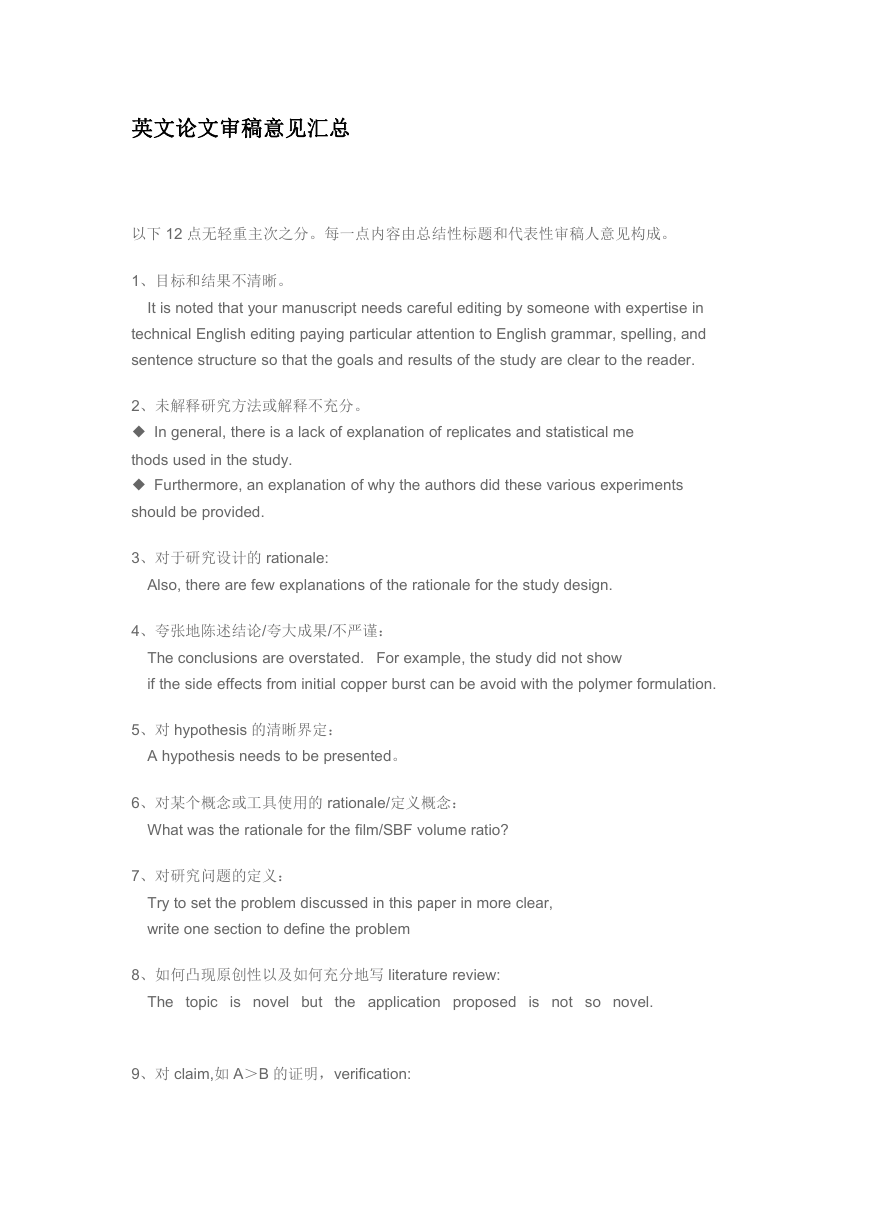
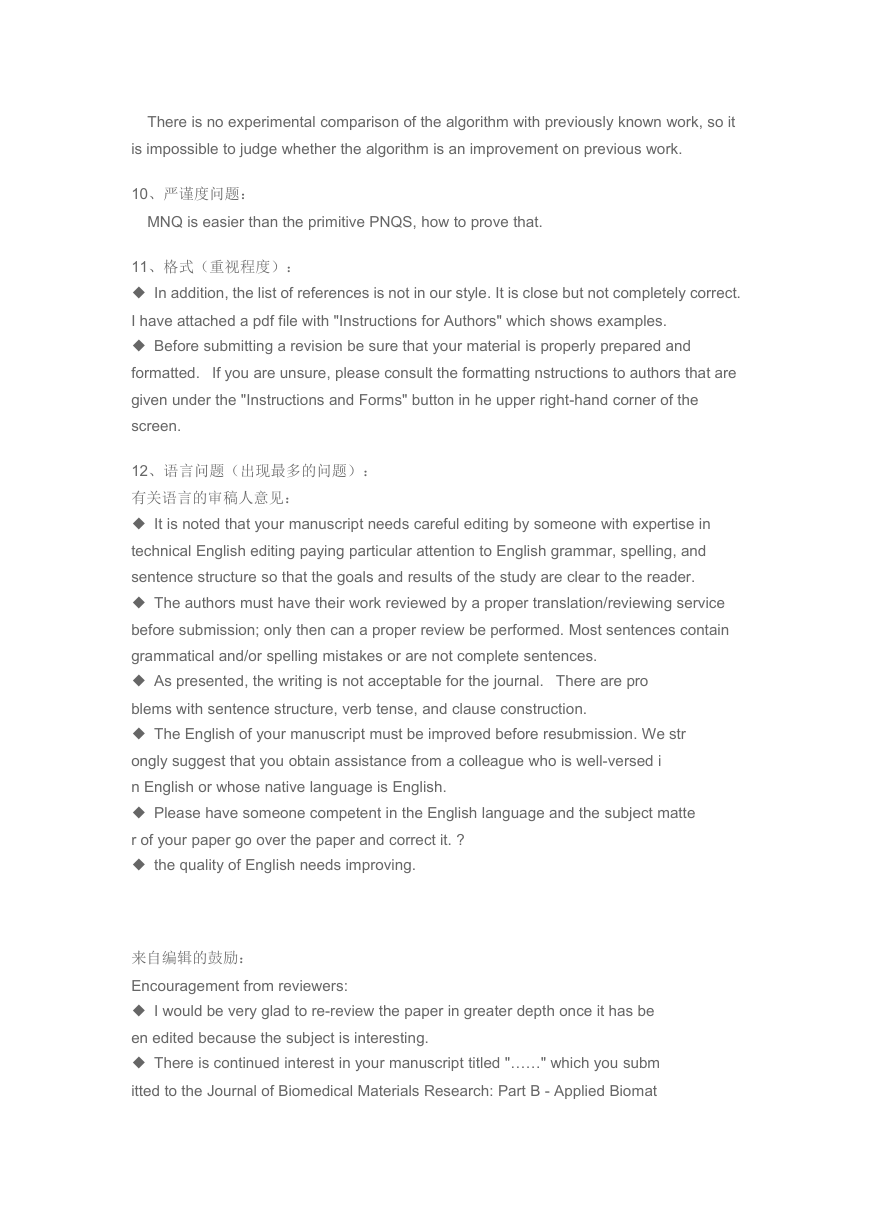
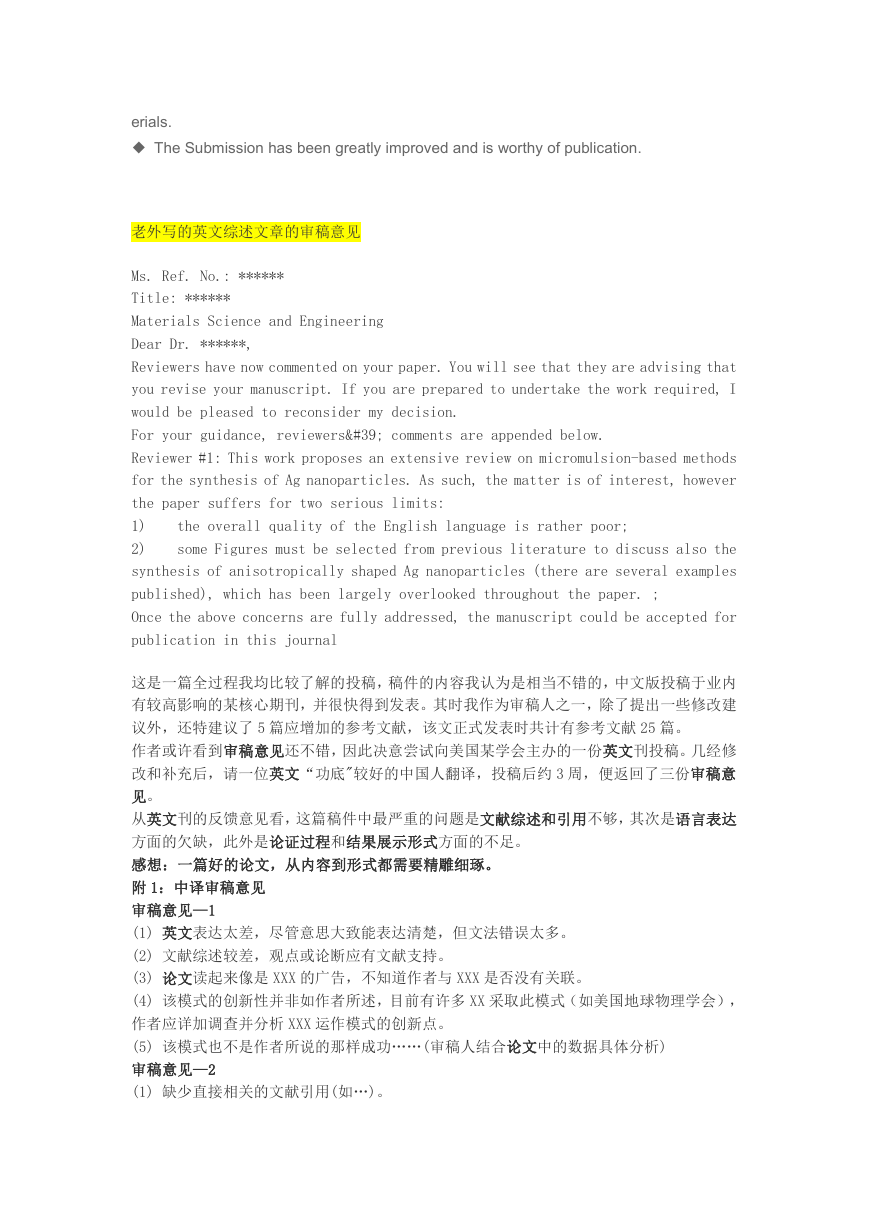

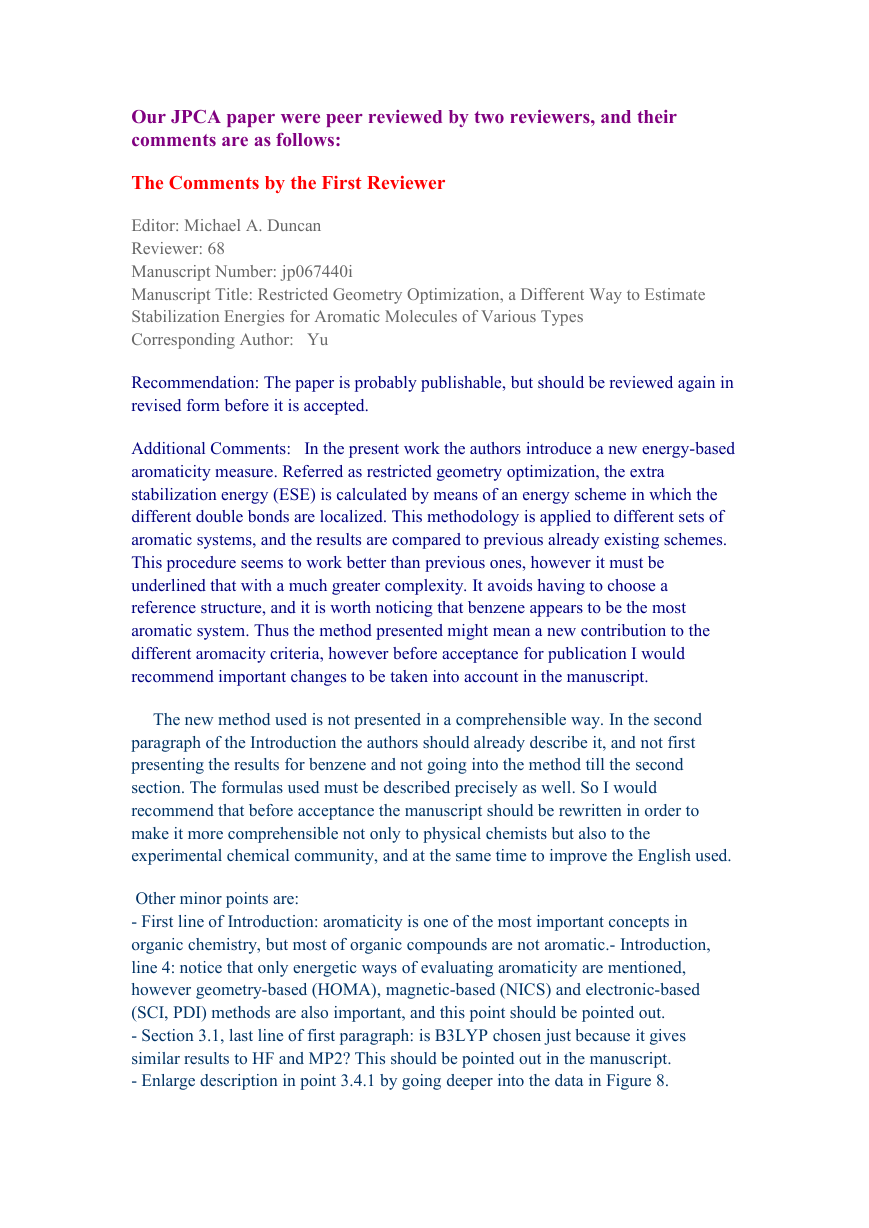
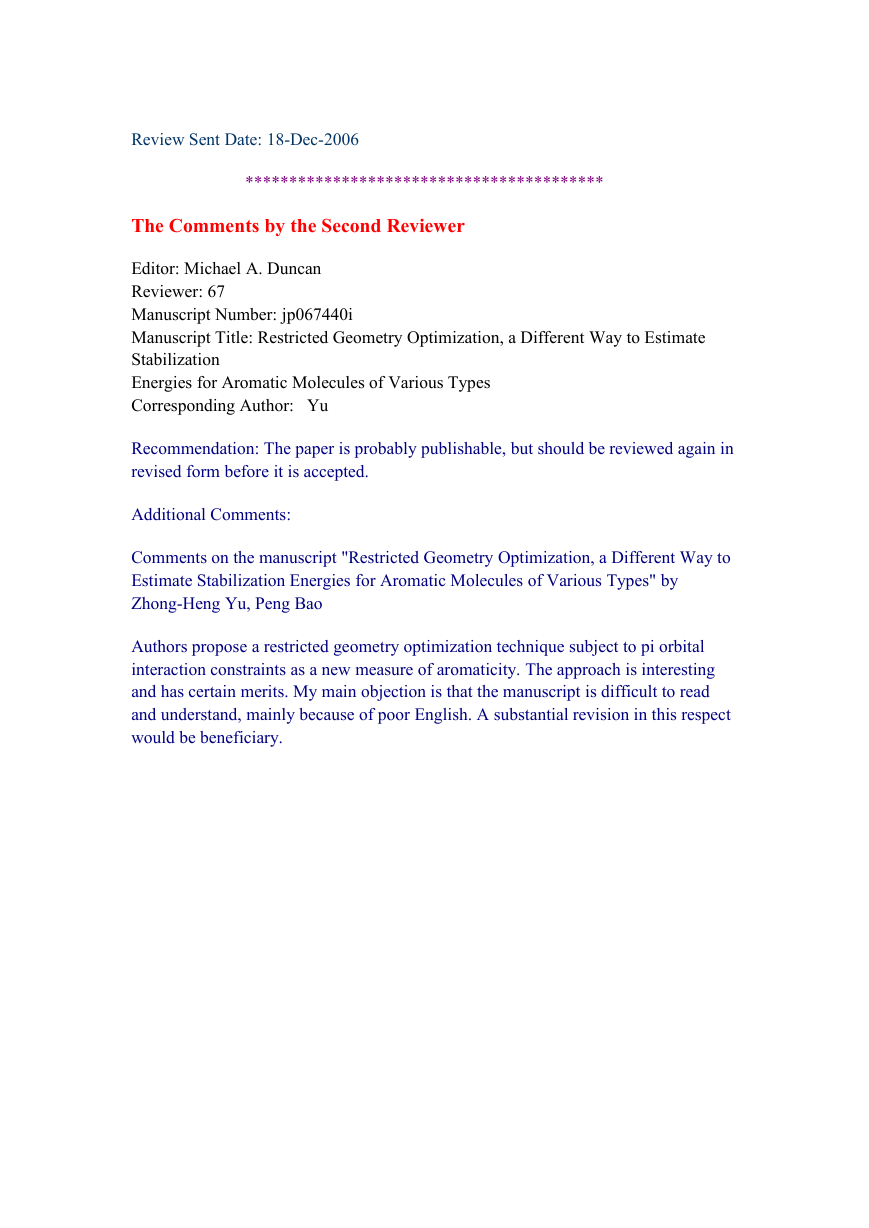
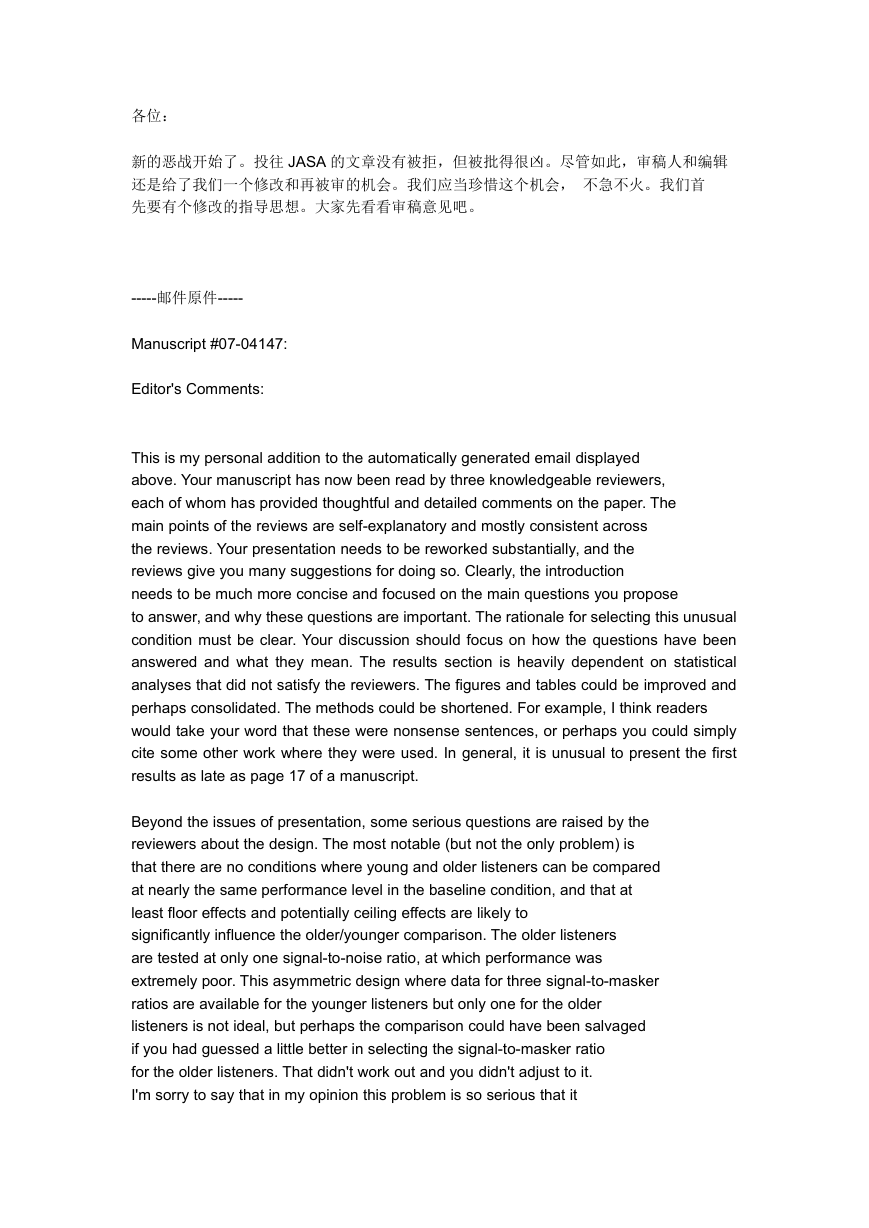
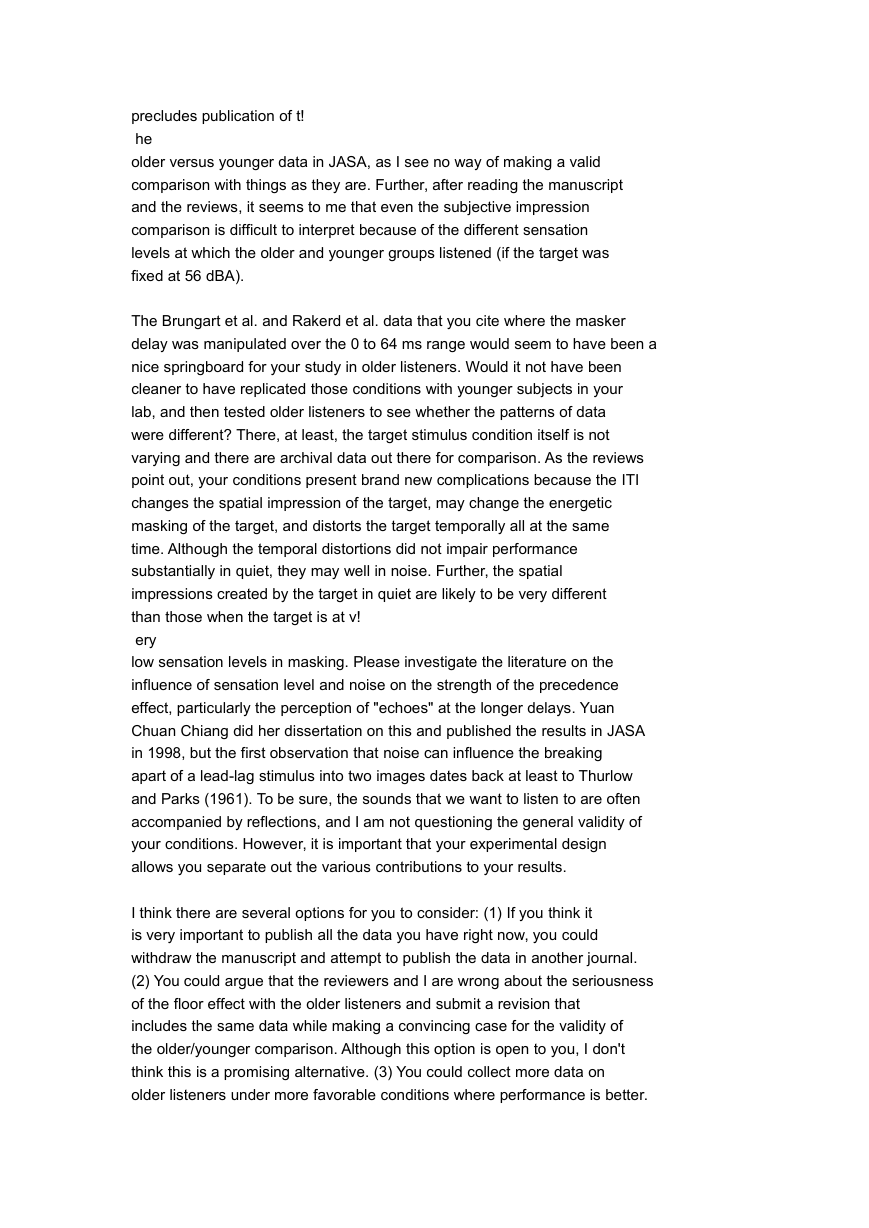








 2023年江西萍乡中考道德与法治真题及答案.doc
2023年江西萍乡中考道德与法治真题及答案.doc 2012年重庆南川中考生物真题及答案.doc
2012年重庆南川中考生物真题及答案.doc 2013年江西师范大学地理学综合及文艺理论基础考研真题.doc
2013年江西师范大学地理学综合及文艺理论基础考研真题.doc 2020年四川甘孜小升初语文真题及答案I卷.doc
2020年四川甘孜小升初语文真题及答案I卷.doc 2020年注册岩土工程师专业基础考试真题及答案.doc
2020年注册岩土工程师专业基础考试真题及答案.doc 2023-2024学年福建省厦门市九年级上学期数学月考试题及答案.doc
2023-2024学年福建省厦门市九年级上学期数学月考试题及答案.doc 2021-2022学年辽宁省沈阳市大东区九年级上学期语文期末试题及答案.doc
2021-2022学年辽宁省沈阳市大东区九年级上学期语文期末试题及答案.doc 2022-2023学年北京东城区初三第一学期物理期末试卷及答案.doc
2022-2023学年北京东城区初三第一学期物理期末试卷及答案.doc 2018上半年江西教师资格初中地理学科知识与教学能力真题及答案.doc
2018上半年江西教师资格初中地理学科知识与教学能力真题及答案.doc 2012年河北国家公务员申论考试真题及答案-省级.doc
2012年河北国家公务员申论考试真题及答案-省级.doc 2020-2021学年江苏省扬州市江都区邵樊片九年级上学期数学第一次质量检测试题及答案.doc
2020-2021学年江苏省扬州市江都区邵樊片九年级上学期数学第一次质量检测试题及答案.doc 2022下半年黑龙江教师资格证中学综合素质真题及答案.doc
2022下半年黑龙江教师资格证中学综合素质真题及答案.doc